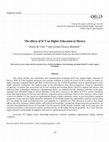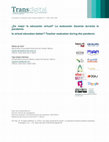Papers by Wietse de Vries
Ciencia latina, Mar 21, 2024
así como analiza los procesos que han influido para configurar el actual escenario educativo a ni... more así como analiza los procesos que han influido para configurar el actual escenario educativo a nivel de Licenciatura para el Licenciado en Farmacia (LF) y Químico Farmacéutico (QF). De 25 programas académicos, 18 cumplen con los lineamientos y recomendaciones internacionales. Se observó discrepancias en la formación de los programas de QF, mientras la LF se caracteriza por la homologación de los planes de estudio en los países que la ofertan. Concluimos que el QF es un grado académico latinoamericano, el cual tiende a estar subregulado, como es lo es el Químico Farmacobiólogo en México, al únicamente tener puntos de comparación regionales. Finalmente planteamos algunas recomendaciones.

Journal of Comparative & International Higher Education, 2024
This article analyzes how information and communication technology (ICT) has changed higher educa... more This article analyzes how information and communication technology (ICT) has changed higher education in Mexico. While ICT has modified operations and working conditions in almost all sectors of the economy, its impact on
higher education remained limited until 2019. In 2020, however, the COVID-19 pandemic led to its rapid adoption in most higher education institutions. Our analysis looks at this phenomenon from three perspectives. Using an educational perspective, we analyze how universities use ICT for teaching and learning. Before 2020, few students and teachers had embraced these technologies. Relying on organizational theory, we analyzed how the structures and rules of the game changed when institutions adapt to outside demands. In this field, research on the effects of ICT in various institutions
shows that organizations can become more efficient, competitive and provide better client services. However, there is little research on whether ICT has caused an organizational change in higher education. Lastly, we use an academic capitalism perspective to ascertain how higher education institutions are knowledge-producing organizations, and how incorporating
ICT can change the mode of production from a pre-capitalist to a capitalist one. This allowed us to look at how change affects who owns, manages, commercializes, and profits from knowledge. Considering changes from these perspectives, we conclude that digitalization favors ICT providers, but this however hardly benefits academic staff. At the same time, the national government is unconvinced of online teaching and has cut the budget during the pandemic. As a result, Mexican higher education will probably de-digitalize and return to traditional forms of instruction.
A new editor, but the road remains the same
Revista mexicana de investigación educativa, Mar 1, 2015
Reforms and Myths
BRILL eBooks, Feb 25, 2019
How to interpret such a large diversity of research
Revista mexicana de investigación educativa, Jun 1, 2015
La evaluacion de la calidad en Argentina: La necesidad de un analisis centrado en el poder y el conflicto
Calidad, eficiencia y evaluacion de la educacion superior
... del proyecto de evaluación y que parecía asumir la problemática del aseguramiento de la ... P... more ... del proyecto de evaluación y que parecía asumir la problemática del aseguramiento de la ... Pero muy de acuerdo a la celeridad con que se formulaban políticas y se ... la adopción de la propuesta " Evaluación para el mejoramiento de la calidad universitaria" como instrumento a ...
al igual que otras universidades mexicanas, ha buscado contribuir al desarrollo del país a través... more al igual que otras universidades mexicanas, ha buscado contribuir al desarrollo del país a través de la apertura de distintos programas educativos. La diversificación de su oferta ha acatado políticas federales y estatales, conjuntamente con consideraciones internas. Aun cuando la apertura y operación de programas implica inversiones importantes, no se han realizado estudios sobre el impacto de cada carrera en la inserción del graduado en el mercado laboral. En este trabajo exploramos la contribución de distintas carreras al trabajo de egresados, con especial énfasis en la satisfacción con el empleo encontrado. Nuestros resultados contradicen décadas de discursos y de políticas diseñadas para modificar el comportamiento de estudiantes.

Transdigital
La pandemia de COVID-19 implicó un cambio radical para la docencia en la Benemérita Universidad A... more La pandemia de COVID-19 implicó un cambio radical para la docencia en la Benemérita Universidad Autónoma de Puebla (BUAP) en México. Prácticamente de un día para el otro, los docentes y estudiantes tuvieron que transitar del modo presencial a la docencia en línea. Esta nueva forma de dar clases continuó hasta el otoño de 2022, cuando casi todos los cursos volvieron al modo presencial. Esta transición generó un debate sobre las ventajas y desventajas de la educación virtual. Este artículo analiza la educación virtual a partir de la evaluación docente, una valoración que los estudiantes hacen cada semestre de sus profesores. El instrumento de evaluación permitió conocer el desempeño docente y el uso de distintos métodos de enseñanza. El período de análisis fue del final de 2019 hasta el final de 2022. Eso permite comparar las calificaciones antes, durante y después de la pandemia. El análisis revela que, en opinión de los estudiantes mejoró el desempeño docente durante la pandemia. Si...
Las tecnologías de la información y de la comunicacion en la educación y el desarrollo. El caso del programa «Aula Digital» de la Ciudad de Mexico
Ciencias de la Información, 2016
This paper describes the main features and objectives of the "Aula Digital" public prog... more This paper describes the main features and objectives of the "Aula Digital" public program, implemented in Mexico City between 2008 and 2009 in order to improve the quality of education of the town and help close the digital gap between Mexican students. The work shows that the digital gap in the use of computers is associated with the existence of other social gaps as it is influenced by the conditions of income and education, so the program studied has a positive impact both on the quality of education, and reducing the digital gap.
Gobernabilidad, cambio organizacional y políticas
Calidad, eficiencia y evaluacion de la educacion superior
Students' preferences towards learning styles have been well documented by research other than Ko... more Students' preferences towards learning styles have been well documented by research other than Kolb's. Pask (1988) for instance, demonstrated students learn best when the instructor's teaching style matches their learning preferences; mismatches, on the other hand, lessened this learning. Research has also shown that students tend to study in academic disciplines most resembling their learning styles (Feldman, 1989). Under some conditions, gender and race can also influence what and how students learn (Oakes, 1990). Opinions differ, however, about the reasons for gender and race-related learning differences. The most compelling argument lies on differences
Avaliação: Revista da …, 2006
Calidad, eficiencia y evaluacion de la educacion superior
¿Dejar la escuela o la vida social? El abandono en la educación media superior en Oaxaca
Revista de la Educación Superior, 2021
In spite of a decade of public policies, higher secondary school dropout continues to be a proble... more In spite of a decade of public policies, higher secondary school dropout continues to be a problem. A central question is what the main reasons are to leave school. Public policies assume that the causes are of an economic or academic nature. However, this study in the state of Oaxaca, Mexico, finds that the chief motivation is not academic. According to many youngsters, they like to go out with friends and partners and have a social live, but this aspect of youth culture is often incompatible with school organization, causing students to flunk and abandon.
Proyecto académico sin fines de lucro, desarrollado bajo la iniciativa de acceso abierto











Uploads
Papers by Wietse de Vries
higher education remained limited until 2019. In 2020, however, the COVID-19 pandemic led to its rapid adoption in most higher education institutions. Our analysis looks at this phenomenon from three perspectives. Using an educational perspective, we analyze how universities use ICT for teaching and learning. Before 2020, few students and teachers had embraced these technologies. Relying on organizational theory, we analyzed how the structures and rules of the game changed when institutions adapt to outside demands. In this field, research on the effects of ICT in various institutions
shows that organizations can become more efficient, competitive and provide better client services. However, there is little research on whether ICT has caused an organizational change in higher education. Lastly, we use an academic capitalism perspective to ascertain how higher education institutions are knowledge-producing organizations, and how incorporating
ICT can change the mode of production from a pre-capitalist to a capitalist one. This allowed us to look at how change affects who owns, manages, commercializes, and profits from knowledge. Considering changes from these perspectives, we conclude that digitalization favors ICT providers, but this however hardly benefits academic staff. At the same time, the national government is unconvinced of online teaching and has cut the budget during the pandemic. As a result, Mexican higher education will probably de-digitalize and return to traditional forms of instruction.
higher education remained limited until 2019. In 2020, however, the COVID-19 pandemic led to its rapid adoption in most higher education institutions. Our analysis looks at this phenomenon from three perspectives. Using an educational perspective, we analyze how universities use ICT for teaching and learning. Before 2020, few students and teachers had embraced these technologies. Relying on organizational theory, we analyzed how the structures and rules of the game changed when institutions adapt to outside demands. In this field, research on the effects of ICT in various institutions
shows that organizations can become more efficient, competitive and provide better client services. However, there is little research on whether ICT has caused an organizational change in higher education. Lastly, we use an academic capitalism perspective to ascertain how higher education institutions are knowledge-producing organizations, and how incorporating
ICT can change the mode of production from a pre-capitalist to a capitalist one. This allowed us to look at how change affects who owns, manages, commercializes, and profits from knowledge. Considering changes from these perspectives, we conclude that digitalization favors ICT providers, but this however hardly benefits academic staff. At the same time, the national government is unconvinced of online teaching and has cut the budget during the pandemic. As a result, Mexican higher education will probably de-digitalize and return to traditional forms of instruction.